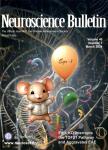Contribution of NMDA receptors to dorsolateral prefrontal cortical networks in primates
Contribution of NMDA receptors to dorsolateral prefrontal cortical networks in primates作者机构:Department of Neurobiology Yale Medical School
出 版 物:《Neuroscience Bulletin》 (神经科学通报(英文版))
年 卷 期:2015年第31卷第2期
页 面:191-197页
核心收录:
学科分类:0710[理学-生物学] 1002[医学-临床医学] 1001[医学-基础医学(可授医学、理学学位)] 100205[医学-精神病与精神卫生学] 10[医学]
基 金:supported by the National Institutes of Health, USA (R01 MH 09335401 and PO1 AG030004) a New Investigator Research Grant from the Alzheimer’s Association
主 题:glutamate Alzheimer's disease schizophrenia depression ketamine
摘 要:Cognitive disorders such as schizophrenia and Alzheimer's disease are associated with dysfunction of the highly evolved dorsolateral prefrontal cortex (dlPFC), and with changes in glutamatergic N-methyI-D-aspartate receptors (NMDARs). Recent research on the primate dlPFC discovered that the pyramidal cell circuits that generate the persistent firing underlying spatial working memory communicate through synapses on spines containing NMDARs with NR2B subunits (GluN2B) in the post-synaptic density. This contrasts with synapses in the hippocampus and primary visual cortex, where GluN2B receptors are both synaptic and extrasynaptic. Blockade of GluN2B in the dlPFC markedly reduces the persistent firing of the Delay cells needed for neuronal representations of visual space. Cholinergic stimulation of nicotinic (17 receptors within the glutamate synapse is necessary for NMDAR actions. In contrast, a-amino-3-hydroxy-5-methyl-4-isoxazolepropionic acid receptors have only subtle effects on the persistent firing of Delay cells, but contribute substantially to the firing of Cue and Response cells. Systemic administration of the NMDAR antagonist ketamine reduces the persistent firing of Delay cells, but increases the firing of some Response cells. The reduction in persistent firing produced by ketamine may explain why this drug can mimic or worsen the cognitive symptoms of schizophrenia. Similar actions in the medial PFC circuits representing the emotional aspects of pain may contribute to the rapid analgesic and anti-depressant actions of ketamine.



